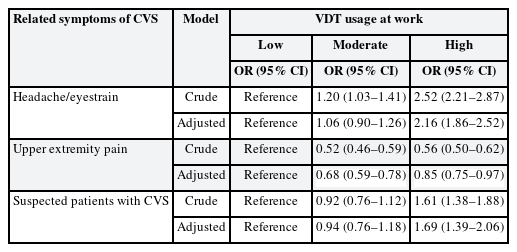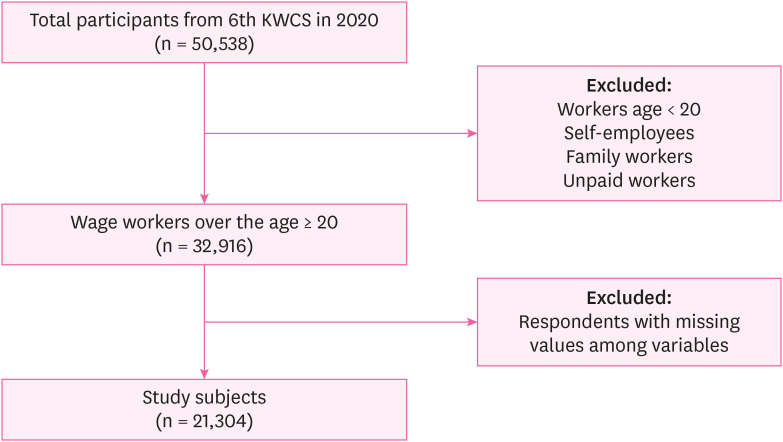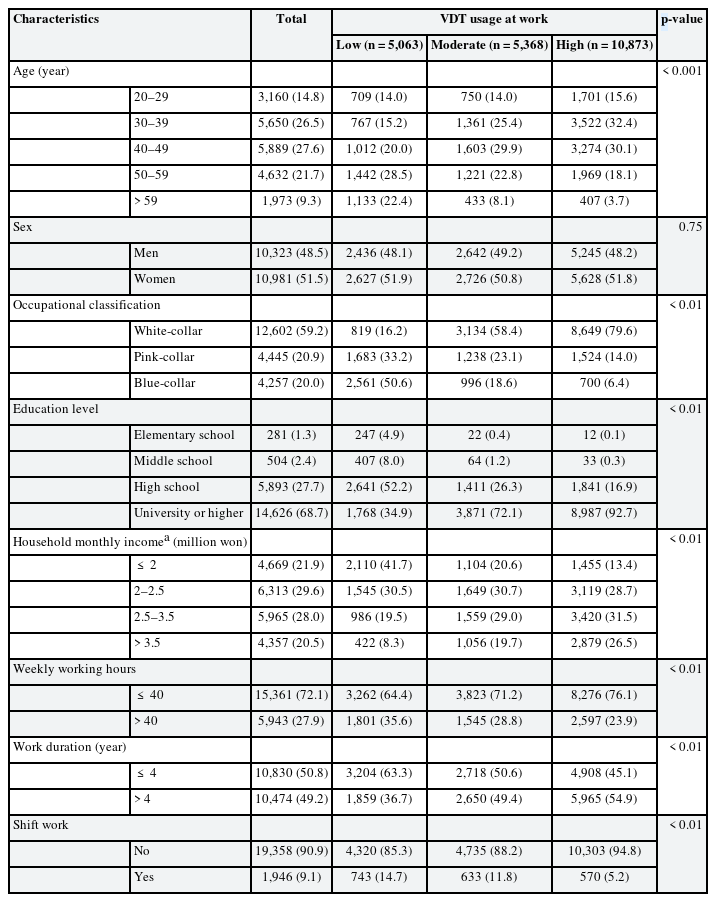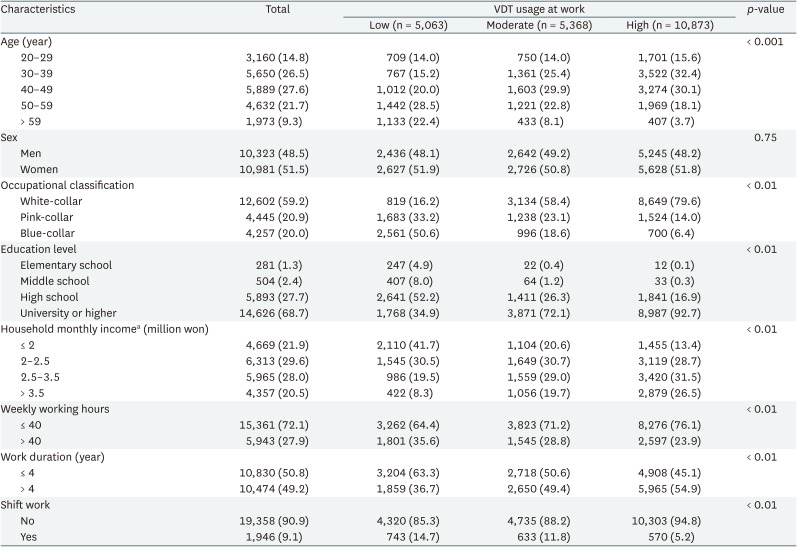The relationship between visual display terminal usage at work and symptoms related to computer vision syndrome
Article information
Abstract
Background
Although it is well known that the usage of visual display terminal (VDT) at the workplace causes computer vision syndrome (CVS), previous studies mainly focused on computer use and the health of white-collar workers. In this study, we explored the relationship between the usage of VDT including various devices, and symptoms related to CVS in a large population including pink-collar workers and blue-collar workers.
Methods
21,304 wage workers over the age of 20 years were analyzed from the 6th Korean Working Conditions Survey. To investigate the association between VDT use at work and symptoms related to CVS among wage workers, odds ratios (ORs) and 95% confidence interval (CI) were calculated by multivariate logistic regression models.
Results
In the group with the highest VDT usage at work, the OR of headache/eyestrain was 2.16 (95% CI: 1.86–2.52). The OR of suspected CVS patients was significantly increased in the highest group of usage of VDT at work (OR: 1.69; 95% CI, 1.39–2.06). Compare with the reference group, the OR for headache/eyestrain in the highest group of VDT usage was 2.81 (95% CI: 2.13–3.70) in white-collar workers, 1.78 (95% CI: 1.32–2.40) in pink-collar workers, and 1.59 (95% CI: 1.18–2.15) in blue-collar workers.
Conclusions
We observed a relationship in which the use of VDT in the workplace increases the risk of headache/eyestrain regardless of occupational classification. Our findings emphasize the importance of paying attention to the health of VDT workers and making plans to improve their working conditions.
BACKGROUND
Visual display terminals (VDT) have become essential components of life as science and technology have advanced. The advent of personal computers revolutionized the workplace 40 years ago, and today, a variety of electronic gadgets, such as tablets and smartphones, are infiltrating various workplaces.12 According to the 6th European Working Conditions Survey, more than half of workers in Europe use VDT at work, and 37% of workers use VDT for more than 75% of their work hours.3 In Korea, 65.8% of workers use computers at work, and 40.4% use computers for more than 80% of their work hours.4
Computer vision syndrome (CVS) is a syndrome characterized by eye-related symptoms in users who use VDT for a long time.5 CVS is common in individuals who work with VDT, and its prevalence is reported to vary from 18% to 80%.67 Symptoms of CVS are divided into 2 categories: ocular symptoms, such as eyestrain, blurry vision, asthenopia, and dry eyes; and extraocular symptoms, such as musculoskeletal pain of the upper extremity.8 Headache was included in this categorization as an ocular symptom because it is closely related to eye strain.2 Previous studies have indicated that eyestrain is frequently accompanied or preceded by headache.910 According to a study that determined various causes of asthenopia, the same stimulus provoked headaches and eyestrain.11 Eyestrain and headache can be triggered by spasms of muscles around the orbit, and impairments in accommodation and convergence can also contribute to their occurrence.1213
The health effects of VDT usage at work have been thoroughly investigated. Workers using VDT frequently complain of eye symptoms.1415 Moreover, working with VDT for an hour result in alterations in accommodative function and ocular convergence.1617 Many studies have recognized VDT usage at work as a risk factor for musculoskeletal pain in the neck, shoulders, elbows, and wrists.15 The risk of developing CVS increases proportionally to the duration of VDT exposure.1819
However, previous studies have mainly focused on office workers who spend considerable time with computers in the workplace.151920 Most epidemiological studies have focused on small populations with specific occupations, such as healthcare workers and call center operators.142122 There is a scarcity of research on the relationship between VDT usage at work and health problems in pink-collar workers and blue-collar workers. In previous research, the usage of smartphones and tablets was not considered and only the impacts of computer use on workers' health were examined.14151617192021 This is because earlier research was done between the 1980s and the 2000s before smartphones and tablets were invented.1415161720 As technology has progressed and the workplace environment has evolved, the effects of the use of VDT including smartphones and tablets on workers’ health need to be investigated.8 We used the definition of VDT which includes smartphones and tablets in this study.
We aimed to investigate the relationship between VDT use at work and health problems in a large population. In addition, the participants were classified into three groups: white-collar, pink-collar, and blue-collar, and then the health effect of the use of VDT was evaluated. To the best of our knowledge, this is the first study to use the extended concept of VDT to explore the health effects in a large population.
METHODS
Study participants
This study was based on cross-sectional data from the 6th Korean Working Conditions Survey (KWCS) conducted in 2020. The KWCS has been conducted every 3 years since 2006 by the Occupational Safety and Health Research Institute in Korea. The KWCS uses a complex survey design that stratifies respondents by house type, residential location, age, sex, and socioeconomic status. The 6th KWCS was performed from October 2020 to April 2021, and one-on-one interviews and non-face-to-face online surveys were conducted at the same time because of the spread of coronavirus disease 2019. A total of 50,538 workers over 15 years of age participated in the 6th KWCS.
First, 32,916 wage workers over the age of 20 years were selected from the 50,538 participants in the 6th KWCS after self-employed individuals and unpaid family workers were excluded. After excluding respondents with missing data regarding health problems or questions of other covariates, 21,304 participants were analyzed in this study (Fig. 1).
Definition of main variables
Symptoms related to CVS were reported using a self-reported questionnaire included in the 6th KWCS. The presence of headache or eyestrain was determined by answering yes or no to the question “Have you had headache or eyestrain in the last 12 months?” The presence of upper extremity pain was determined by answering yes or no to the question “Have you had musculoskeletal pain of the neck, shoulder, elbow, arm, wrist, or hand in the last 12 months?” Those who answered yes to both of the above questions were defined as patients with suspected CVS.
A survey was also conducted on the use of VDT in the workplace. Participants in the 6th KWCS answered by a seven-point scale (all working hours, almost all working hours, approximately 75% of working hours, approximately 50% of working hours, approximately 25% of working hours, rarely, never) to the question “How often do you use your computer, laptop, tablet, or smartphone during work hours?”. No participant answered this question with “never.” These responses were categorized into three categories: low (“rarely”), moderate (“approximately 25% of working hours” or “approximately 50% of working hours”), and high (“approximately 75% of working hours” or more frequently).
Covariates
Potential confounding variables included sex, age (20–29, 30–39, 40–49, 50–59, and ≥ 60 years), education level (graduation from elementary school or lower, graduation from middle school or lower, graduation from high school or lower, admission to university or higher), and household monthly income (quartiles). The occupations of the study population were classified into 11 types based on the Korean Standard Classification of Occupations in the 6th KWCS. We classified participants’ jobs into three categories: white collar, pink collar, and blue collar. Managers, professionals, researchers, and office workers were designated as white-collar workers; employees in the service and sales industries were referred to as pink-collar workers; farmers, fishermen, workers in the forestry and livestock industry, artisans, technical workers, hardware operators, and manufacturing workers, and unskilled laborers were designated as blue-collar workers. Other covariates related to occupational characteristics included shift work (yes or no), weekly working hours (≤ 40 hours per week or > 40 hours per week), and work duration (< 5 years or ≥ 5 years).
In additional analyses, ergonomic factors were defined by survey questions in the 6th KWCS. Participants of the 6th KWCS could answer on a seven-point scale (all working hours, almost all working hours, approximately 75% of working hours, approximately 50% of working hours, approximately 25% of working hours, rarely, never) to the question of painful posture, heavy lift, standing posture, sitting posture, and repetitive hand or arm movements. These responses were categorized into three categories: low (“never” or “rarely”), moderate (“approximately 25% of working hours” or “approximately 50% of working hours”), and high (“approximately 75% of working hours” or more frequently).
Confounding factors were selected based on prior research. Age over 30 was identified as a risk factor for VDT-related dry eye syndrome.23 In the same study, it was confirmed that VDT-related dry eye syndrome is more prevalent in women more than in men.23 There have been reports that the higher the income, the lower the risk of symptoms of CVS.19 Working hours and duration of work were positively associated with significant presence of CVS.824 The direct relationship between shift work and CVS has not been revealed, but shift work is known to be the cause of the headache and dry eye syndrome.2526
Statistical analysis
To compare the differences in baseline characteristics according to VDT usage at work, we used the Rao–Scott chi-squared test. The Rao–Scott chi-squared test enables to compare differences between groups by considering the weights given in the complex sample survey.27 Odds ratios (ORs) and 95% confidence intervals (95% CIs) for related symptoms of CVS with respect to VDT usage at work were determined using multivariate logistic regression models adjusted for age, sex, occupational classification, household monthly income, weekly working hours, duration of work, and shift work. Potential covariates were selected for the adjusted model based on prior research, and education level was excluded using backward stepwise selection. IBM SPSS (version 19 for Windows; IBM Corp., Armonk, NY, USA) was used to perform all weighted statistical analyses. Statistical significance was defined as p < 0.05.
Multicollinearity among covariates is problematic when performing multivariate logistic regression analysis. To consider the multicollinearity, Spearman's rank correlation coefficient rho and the variance inflation factor (VIF) were calculated to test multicollinearity. The thresholds for collinearity were set at correlation coefficient rho < 0.5 and VIF < 10.
Ethics statement
The Institutional Review Board (IRB) of Kyung Hee University Hospital issued ethics approval for the present study (No. KHUH 2022-05-022). Since the researchers analyzed the database retrospectively, the IRB waived the informed consent requirement.
RESULTS
Table 1 shows the general characteristics of the study participants according to VDT usage at work. This study included 10,323 men and 10,981 women. There were significant differences in age, occupational classification, household monthly income, weekly working hours, duration of work, and shift work between the three groups. With regard to sex, however, no differences were observed among the three groups. In the group with high VDT usage at work, the distribution of those in their 50s and 60s was lower, the proportion of those admitted to university or higher was higher, and the proportion of white-collar workers was higher.
Logistic regression analysis was performed to estimate the association between VDT use at work and the related symptoms of CVS (Table 2). In the group with the highest VDT usage at work, the adjusted odds ratio of headache/eyestrain was 2.16 (95% CI: 1.86–2.52). The use of VDT at work has been shown to lower the risk of upper extremity pain. The OR between VDT exposure and upper extremity pain was 0.68 (95% CI: 0.59–0.78) in the moderate VDT use group and 0.85 (95% CI: 0.75–0.97) in the highest VDT use group. Compared with the reference group, the odds ratio of suspected patients with CVS was significantly higher in the group with highest the VDT use at work (OR: 1.69; 95% CI: 1.39–2.06).

Multiple logistic regression results for symptoms related to CVS according to VDT usage at work (n = 21,304)
Similar results and tendencies were observed in the subgroup analysis after stratification by occupational classification. The adjusted odds ratio for headache/eyestrain in the highest group compared to the reference group was 2.81 (95% CI: 2.13–3.70) in white-collar workers, 1.78 (95% CI: 1.32–2.40) in pink-collar workers, and 1.59 (95% CI: 1.18–2.15) in blue-collar workers (Table 3). In addition, the use of VDT in the workplace was found to reduce the risk of upper extremity pain in all occupational classifications (Table 3). The odds ratio for suspected patients of CVS in the highest VDT usage group compared to the lowest VDT usage group was 1.86 (95% CI: 1.32–2.62) in white-collar workers and 1.50 (95% CI: 1.02–2.22) in pink-collar workers.

Multiple logistic regression results for symptoms related to CVS according to VDT usage at work after stratification by occupational classification (n = 21,304)
In the fully adjusted model, age, sex, weekly working hours, and work duration were associated with an increased risk of suspected patients of CVS (Supplementary Table 1). After stratification by sex, as the use of VDT increased, the adjusted odds ratio of headache/eyestrain increased, the adjusted odds ratio of upper extremity pain decreased, and the adjusted odds ratio of suspected patients with CVS increased, regardless of sex (Supplementary Table 2). According to a correlation matrix among covariates in Supplementary Table 3, the correlation coefficient ranged from −0.38 to 0.42 and VIF ranged from 1.04 to 1.60. Consequently, we determined that multicollinearity was low.
DISCUSSION
The present study showed that VDT usage at work was associated with an increased risk of headache/eyestrain. Additionally, the use of VDT increased the risk of suspected CVS patients in white-collar workers and pink-collar workers. This result is in line with many previous studies that show that using VDT at work increases the risk of CVS.14192228 However, VDT usage at work was not significantly associated with suspected CVS patients in blue-collar workers.
We observed that the use of VDT in the workplace increased the risk of headache/eyestrain in all occupational classifications. The ocular symptoms of CVS originate from differences between electronic screens and papers. Images on electronic screens are made up of pixels and rasters, which are generated by electric waves that impact the screen’s phosphor-coated rear surface.29 The pixels are bright at the center and become less bright at the rim. As a result, human eyes are unable to maintain a focus on pixel characters for a long time.30 Therefore, researchers have reported that when viewing electronic screens, work errors increase and eye symptoms worsen compared to those when viewing paper.3132 There have also been previous studies on changes in accommodative and vergence functions after using VDT.133 Focusing on the monitor for a long time reduces the rate of blinking and increases corneal exposure, which causes symptoms of CVS, such as the dry eye.3234
Headache is a common symptom of CVS. Mechanisms have been postulated to explain the appearance of headaches in CVS. Two hours of computer use increases the muscle load and blood flow of the orbicularis oculi, resulting in eyestrain.35 In addition, some researchers have suggested that eyestrain and headache can be induced by certain streak and flicker patterns on displays.128 Eye strain and headache usually appear simultaneously and are exacerbated by impaired vision and dry eye.9 As a result, it is difficult to distinguish between headache and eyestrain in ophthalmology.11
In this study, VDT use at work had a protective effect against upper extremity pain. These findings are completely contradictory to the results of previous studies that found that using VDT causes musculoskeletal pain in the upper extremity. These results would have been shown because pink-collar workers and blue-collar workers who frequently use VDT at work in a relatively comfortable posture and better working environment. The VDT workstation is designed to let workers use their hands to operate the device while looking at the monitor in a sedentary position. However, all the variables of postures and heavy lifting were not considered covariates in the analyses because they interacted with VDT use at work (p for interaction < 0.25, considered statistically significant).
Additional analyses were conducted on how ergonomic factors affect upper extremity pain in white-collar workers (Supplementary Table 4). Painful posture and heavy lifting work increased the risk of upper extremity pain. In previous studies on workers in the same working environment and posture, the extensive use of VDT increased the risk of upper extremity pain.836 The group with the frequently repeated movement of the hand or arm had a significantly higher odds ratio of upper extremity pain. These findings indicate that frequent use of keyboards and mouse can increase the risk of upper extremity pain.
To our knowledge, this study is the first to investigate the effect of VDT use on human health in large population groups with various occupations. Unlike previous studies that defined VDT use only as computer use, we conducted research by including devices such as tablets, smartphones, and laptops, in the concept of VDT. This effort is thought to be appropriate for the era of the Fourth Industrial Revolution as VDT are becoming more widespread in the workplace. Furthermore, we conducted stratified subgroup analyses based on occupational classifications and sex, which could be a strength of this study.
However, this study had some limitations. First, we were unable to investigate the use of VDT outside the workplace. Since the KWCS is a survey of the working environment, there is a lack of questions about daily life. The use of smartphones and laptops in daily life can greatly influence headaches and eyestrain. Second, we did not consider the underlying diseases and conditions affecting the symptoms of CVS, such as wearing contact lenses. Some studies have shown that slight uncorrected astigmatism increases the risk of CVS symptoms.3738 In addition, it has been suggested that patients with Sjögren’s syndrome are vulnerable to CVS.32 Wearing contact lenses is a well-known risk factor for CVS.32 The placement of a contact lens on the cornea has been demonstrated to significantly alter the blink rate.39 Tauste et al. reported that wearing contact lenses increases the risk of CVS when working on computers.40 Third, as mentioned above, the variables of ergonomic risk factors were not considered as confounding factors in the adjusted model. Fourth, a self-report survey of health problems and VDT usage at work could be inaccurate. Fifth, selection bias could not be eliminated in this study. The 21,304 subjects in this study were 64.7% of the 32,916 subjects analyzed. 35.3% were excluded from the analysis according to the non-response of the variable, which may have led to a non-response bias. A response rate of more than 60% is acceptable in studies that use surveys, and a rate of more than 80% is considered to be excellent.41 The sociodemographic differences were observed between the participants and non-respondents (Supplementary Table 5). It was confirmed that the non-responders had a lower socioeconomic level than the study participants. Therefore, there was a possibility that the results of this study might have been biased. Finally, causal relationships could not be determined, because this study is a cross-sectional study.
CONCLUSIONS
This study reaffirmed the strong relationship between headache/eyestrain and VDT use at work. A positive association between the use of VDT at work and headache/eyestrain was observed even in blue-collar workers. The Ministry of Employment and Labor of the Republic of Korea has distributed guidelines for work management for workers handling VDT, but there is a lack of supervision and education at the workplace. Our findings highlight the need to pay attention to the health of VDT workers and plan for a better working environment.
ACKNOWLEDGEMENTS
The authors would like to express their gratitude to the participants and researchers of Korean Working Conditions Survey (KWCS).
Notes
Funding: This study was supported by the National Research Foundation of Korea in 2020 (grant number: 2020R1G1A1102257). The funding organization had no role in the design or performance of this study.
Competing interests: The authors declare that they have no competing interests.
Author Contributions:
Conceptualization: Shin S.
Data curation: Ryoo JH.
Formal analysis: Shin S, Yang EH, Lee HC, Moon SH.
Funding acquisition: Ryoo JH.
Methodology: Shin S, Yang EH, Ryoo JH.
Supervision: Ryoo JH.
Visualization: Lee HC, Moon SH.
Writing - original draft: Shin S, Ryoo JH.
Writing - review & editing: Shin S, Ryoo JH.
Abbreviations
CI
confidence interval
CVS
computer vision syndrome
KSWC
Korean Working Conditions Survey
OR
odds ratio
VDT
visual display terminal
VIF
variance inflation factor
References
SUPPLEMENTARY MATERIALS
Supplementary Table 1
Multiple logistic regression results for symptoms related to CVS according to VDT usage at work after stratification by sex (n = 21,304)
Supplementary Table 2
Multiple logistic regression results for symptoms related to CVS according to variables (n = 21,304)
Supplementary Table 3
Correlation matrix among variables
Supplementary Table 4
Odds ratios for upper extremity pain by ergonomic risk factors in white-collar workers (n = 12,602)
Supplementary Table 5
Comparison of characteristics between study subjects and non-respondents





